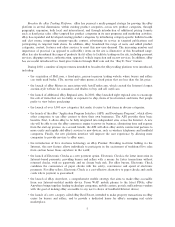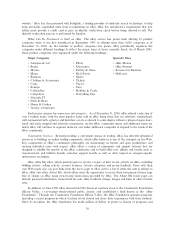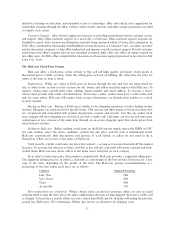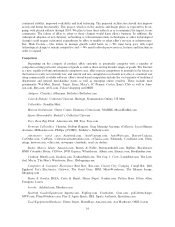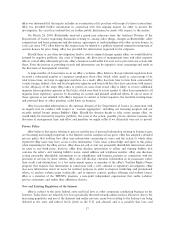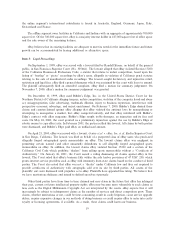eBay 2000 Annual Report Download - page 18
Download and view the complete annual report
Please find page 18 of the 2000 eBay annual report below. You can navigate through the pages in the report by either clicking on the pages listed below, or by using the keyword search tool below to find specific information within the annual report.the members' choice). Information on Half.com's systems is regularly archived for record-keeping and
analysis purposes. Half.com is expecting to accelerate their ongoing eÅort to oÅer enhanced search features.
eBay's system has been designed around industry standard architectures and has been designed to reduce
downtime in the event of outages or catastrophic occurrences. The eBay service provides 24 hour, seven day a
week availability, subject to a maintenance period for a few hours during one night per week. eBay's system
hardware is hosted at the Exodus and Abovenet facilities in Santa Clara, California, which provide redundant
communications lines and emergency power backup. eBay's system consists of Sun database servers running
Oracle relational database management systems with a mix of Sun and Hitachi storage and a suite of
Pentium-based Internet servers running the Windows NT operating system. eBay uses Resonate Inc.'s load
balancing systems and its own redundant servers to provide for fault tolerance. eBay has experienced periodic
system interruptions, which it believes will continue to occur from time to time. These outages have stemmed
from a variety of causes, including third-party hardware and software problems, human error and eBay
proprietary software issues. The volume of traÇc on eBay's website and the number of items being listed by
users has been increasing continually, requiring eBay to expand and upgrade its technology, transaction
processing systems and network infrastructure and add new engineering personnel. The process of upgrading
and expansion is part of the routine maintenance and revision of the site. Hardware and software changes
associated with the continuous revision have been capitalized in accordance with company policy and are
included in computer equipment and software. Due to the speed of change and continuous nature of site
revision, internal expenses often are judged to have useful lives of less than one year, or have been more
appropriately classiÑed as maintenance-related costs. As such, these costs are expensed as incurred. eBay may
be unable to accurately project the rate or timing of increases, if any, in the use of the eBay service or expand
and upgrade its systems and infrastructure to accommodate these increases in a timely manner. Any failure to
expand or upgrade its systems at least as fast as the growth in demand for capacity could cause the website to
become unstable and possibly cease to operate for periods of time. Unscheduled downtime could harm eBay's
business.
eBay uses internally developed systems to operate its service and for transaction processing, including
billing and collections processing. eBay must continually improve these systems to accommodate the level of
use of its website. In addition, eBay may add new features and functionality to its services that would result in
the need to develop or license additional technologies. eBay's inability to add additional software and hardware
or to upgrade its technology, transaction processing systems or network infrastructure to accommodate
increased traÇc or transaction volume could have adverse consequences. These consequences include
unanticipated system disruptions, slower response times, degradation in levels of customer support, impaired
quality of the users' experience on its service and delays in reporting accurate Ñnancial information. eBay's
failure to provide new features or functionality also could result in these consequences. eBay may be unable to
eÅectively upgrade and expand its systems in a timely manner or integrate smoothly any newly developed or
purchased technologies with its existing systems. These diÇculties could harm or limit its ability to expand its
business. See ""Risk Factors Ì The inability to expand our systems may limit our growth and Ì System
failures could harm our business.''
eBay incurred $4.6 million, $24.8 million and $55.9 million in product development expenses in 1998,
1999 and 2000, respectively. eBay anticipates that it will continue to devote signiÑcant resources to product
development in the future as it adds new features and functionality to the eBay service. eBay capitalizes
hardware and software associated with added features or functionality in accordance with company policy and
includes such amounts in computer equipment and software. Internal expenses are often judged to have useful
lives of less than one year, or have been more appropriately classiÑed as maintenance-related costs. As such,
these costs are expensed as incurred. The space in which eBay competes is characterized by rapidly changing
technology, evolving industry standards, frequent new service and product announcements, introductions and
enhancements and changing customer demands. Accordingly, eBay's future success will depend on its ability
to adapt to rapidly changing technologies, adapt its services to evolving industry standards and to improve the
performance, features and reliability of its service in response to competitive service and product oÅerings and
evolving demands of the Internet. To address the need for rapid change as well as stability, eBay has
undertaken a project to enhance its current architecture. The new architecture is intended to facilitate
13




